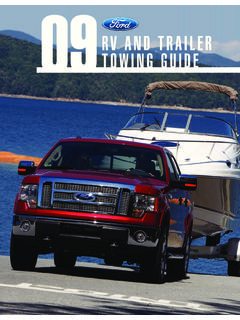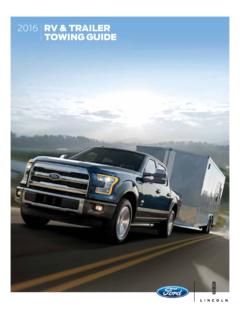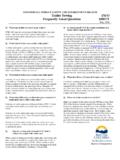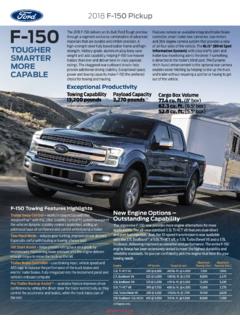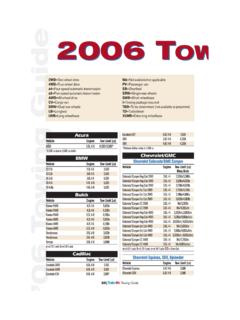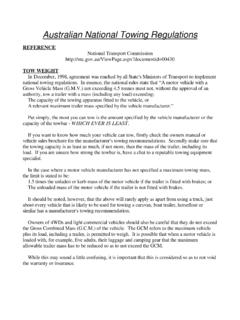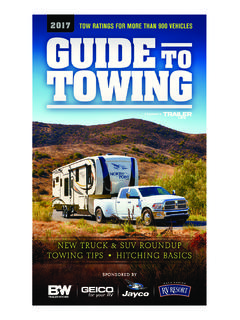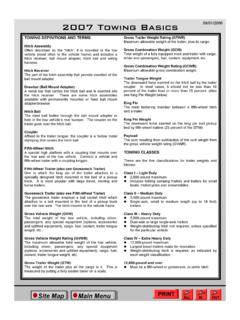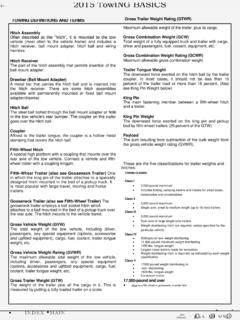Transcription of Towing A TrAiler - vucna-sluzba-rados.hr
1 Hitch Systems, Towing Packages, & Driving Permits Towing A TrAiler Being Equipped For Safety Table of Contents 1 Introduction 2 Selecting a Tow Vehicle 4 If You Already Have a Tow Vehicle 7 Connecting Your TrAiler to Your Tow Vehicle 11 Tire Safety 12 Loading and Weight Distribution 13 State and Local Requirements for Towing 15 Pre-departure Safety Checklist 17 Safety Tips for Driving With a TrAiler 21 Maintenance 24 Resources Introduction H itch systems, Towing packages, tongue weight, and driving permits there's a lot more to Towing a TrAiler than just hitching up and taking off down the road. This brochure provides general information and tips that can help you make safe decisions when purchasing and driving a tow vehicle and TrAiler for noncommercial, personal use.
2 It covers the following topics: How the size and weight of a TrAiler affect the selection of a tow vehicle Things to consider if you already have a tow vehicle The importance of TrAiler manufacturers' tow ratings How to measure the weight of a TrAiler The hitching, braking, and wiring systems that connect tow vehicles with trailers Tire safety Proper loading and weight distribution of cargo and equipment State and local requirements for Towing a TrAiler A pre-departure checklist Safety tips for driving with a TrAiler Safety tips for maintaining a tow vehicle and TrAiler This brochure is not a substitute for the technical information found in manufacturers' Towing guides and vehicle owner's manuals. Its purpose is to give you some basic information about factors to consider and equipment you will need to ensure your safety and that of your passengers, as well as the safety of other people on the road, when you are Towing a TrAiler .
3 Page 1. Towing packages also may include the TrAiler hitch Selecting a Tow Vehicle M ost SUVs, pickup trucks, vans, minivans, and passenger cars can be equipped to tow a TrAiler . However, the selection of an appropriate tow vehicle and the proper equipment to tow a TrAiler depends on the type of TrAiler , its size and weight, and the amount of weight being towed. There are numerous types of trailers, but in general they fall into four categories: flatbed or open trailers, boat trailers, enclosed trailers, and recreational vehicle trailers (including travel trailers, fifth-wheel trailers, and folding camping trailers). Check the owner's manual and review the manufacturer's guide to see if the vehicle you plan to buy can tow a TrAiler . After you have reviewed the vehicle capabilities, you also must investigate the capabilities of compatible hitch systems for the vehicle.
4 This is especially important if you plan to purchase a hitch from a source other than the vehicle manufacturer. You may find that vehicle manufacturers offer specially designed Towing packages that define the equipment necessary to tow different types of trailers depending on their fully loaded weight and size. A Towing package may include a heavy- duty radiator, battery, flasher system, alternator, suspension, and brakes, as well as an engine-oil cooler, transmission-oil cooler, wiring harness, specific axle ratio, and special wheels and tires. page . Towing packages also may include the TrAiler hitch receiver, which is mounted to the tow vehicle, but Towing packages rarely include the draw bar, or ball mount, and hitch ball. The draw bar is a separate assembly on which the hitch ball is mounted.
5 The draw bar then slides into the hitch receiver on the tow vehicle and is secured with a locking pin. The front part of the TrAiler that hitches to the tow vehicle is referred to as the tongue. At the end of the tongue is a coupler into which the hitch ball is inserted and secured. A manufacturer may offer different Towing packages to safely tow various sizes and types of trailers. Towing packages indicate both equipment that must be installed on your tow vehicle and equipment that is optional or recommended. For example, not all trailers require the tow vehicle to be equipped with extended side-view mirrors. But if you are Towing a TrAiler that is wider than your tow vehicle, you will need extended side-view mirrors to see rear- and side- approaching traffic. page.
6 If You Already Have a Tow Vehicle I f you already have a tow vehicle, look up its tow rating size, maximum loaded weight, and maximum tongue weight of a TrAiler that the tow vehicle is capable of Towing . The vehicle owner's manual contains these specifications. Most automotive manufacturers and dealerships have Towing specification guides with tow ratings and detailed information if extra equipment is needed to tow a TrAiler . While your vehicle may have certain tow ratings, remember you must have a matching hitch system that can handle the same specifications. To ensure safety, you may have to install extra Towing equipment. Manufacturers' Tow Vehicle Ratings Manufacturers' tow vehicle ratings address tongue weight as well as the individual, combined, and fully loaded weights at which a tow vehicle can safely tow a TrAiler .
7 They also can be used to guide the selection of brake and hitching systems as well as tow vehicle tires. Together with the hitch system specifications, these weight considerations will help you purchase a safe tow vehicle. In general, manufacturers provide tow ratings for the maximum Amount the tow vehicle may weigh when fully loaded, or gross vehicle weight rating (GVWR). Weight a vehicle can tow. This figure may vary depending on the vehicle's equipment, such as a manual or automatic transmission and whether it is equipped with four-wheel drive. page . Permissible combined weight of the tow vehicle, TrAiler , passengers, equipment, fuel, etc., that the vehicle can handle, or gross combination weight rating (GCWR). Weight a single axle can carry, or gross axle weight rating (GAWR).
8 Measuring the Weight of a TrAiler Some manufacturers provide a dry or empty weight for trailers; however, to select a proper tow vehicle and hitching system, you must know how much your TrAiler weighs fully loaded. For example, if you are Towing an open TrAiler that carries a boat or motorcycle, the fully loaded weight includes the weight of the TrAiler with the boat or motorcycle and any additional items being towed, such as fuel tanks, motors, and safety equipment. Develop a realistic estimate of the total weight of your TrAiler . The time you spend doing this and getting properly equipped will save you time and money in preventing unexpected repairs to your tow vehicle and unanticipated breakdowns while on the road. In addition to speaking with dealers and other individuals who sell and use trailers, the best way to know the actual weight of your TrAiler is to weigh it at a public scale.
9 Page . Manufacturers consider the loaded weight of a TrAiler when specifying tongue weight the amount of the TrAiler 's weight that presses down on the TrAiler hitch. Too little tongue weight can cause the TrAiler to sway. Too much tongue weight can cause many problems, including not enough weight on the front wheels of the tow vehicle. When this occurs, the tow vehicle will be less responsive to steering. A weight-distributing hitch can remedy this problem by transferring weight to the front axle of the tow vehicle. Manufacturers also establish the gross axle weight and provide a rating that denotes the maximum weight a single axle can carry. Knowing these weights will help you when it is time to load your TrAiler . Remember that the gross axle weight rating listed on the tow vehicle's certification label must not be exceeded.
10 Page . Connecting Your TrAiler to Your Tow Vehicle T ow vehicles and trailers must be compatible with hitching, braking, and wiring systems to ensure safety. Hitching Systems The TrAiler Towing industry has developed a classification system that differentiates hitches according to the amount of weight they can tow. This system addresses tongue weight and total weight. Keep in mind that within each classification are numerous hitches made by a variety of manufacturers. The three most common types of hitches are the weight-carrying hitch, the weight-distributing (or load equalizer) hitch, and the fifth-wheel hitch, or gooseneck. Weight-carrying hitches are designed to carry all of the TrAiler 's tongue weight. Weight- distributing hitches are used with a receiver hitch and special parts that distribute the tongue weight among all tow vehicle and TrAiler axles.
